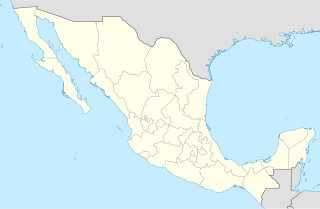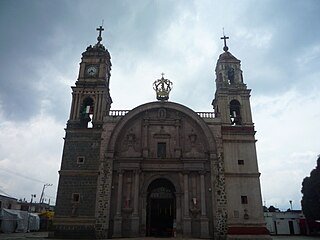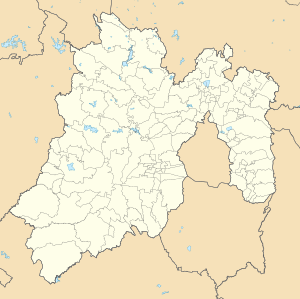Santiago is the capital city of Chile.

San Marcos is a department in northwestern Guatemala, on the Pacific Ocean and along the western Guatemala-Mexico border.

Carlos Hank González (1927–2001), nicknamed El Profesor, was a Mexican politician and influential businessman. Originally a teacher, he was an entrepreneur who built political contacts along with a business empire, leading to various government and political positions at the state and national level. He was prevented from seeking the presidency due to laws requiring both parents to be Mexicans by birth; his father was German. He has been involved in drug trafficking, money laundering, corruption, and criminal threats.

Santiago Tianguistenco, often simply called Santiago by locals, is a city and municipality located in Mexico State about thirty km south of the state capital of Toluca. It is located in the southwest part of the Valley of Toluca at the edge of the Ajusco mountain range that separates it from Mexico City. The name Tianguistenco (Tyanguistengko) is from Nahuatl and means “at the edge of the tianguis,” which is a traditional Aztec market. The section of the city where the industrial park is still bears this name. Historically, the area was known as having one of the richest and best-stocked markets in the Toluca Valley. Today, it is still home to a large permanent municipal market as well as a weekly tianguis that covers much of the historic center.

This article is about the automotive industry in Mexico.

Otomi is an Oto-Pamean language family spoken by approximately 240,000 indigenous Otomi people in the central altiplano region of Mexico. Otomi consists of several closely related languages, many of which are not mutually intelligible. The word Hñähñu[hɲɑ̃hɲṹ] has been proposed as an endonym, but since it represents the usage of a single dialect, it has not gained wide currency. Linguists have classified the modern dialects into three dialect areas: the Northwestern dialects are spoken in Querétaro, Hidalgo and Guanajuato; the Southwestern dialects are spoken in the State of Mexico; and the Eastern dialects are spoken in the highlands of Veracruz, Puebla, and eastern Hidalgo and villages in Tlaxcala and Mexico states.

Metepec is a city and municipality in the State of Mexico in Mexico and is located directly to the east of the state capital, Toluca, at an altitude of 2,635 metres (8,645 ft) above sea level. The centre of Mexico City lies some 50 km further to the east. The name Metepec comes from Náhuatl meaning hill of the maguey plants. However, it is also known in the Matlatzinca language as "Nepinta-Tuhi" meaning 'people of corn land' and in the Otomi language as "Ntaguada".

The Oto-Pamean languages are a branch of the Oto-Manguean languages that includes languages of the Otomi-Mazahua, Matlatzinca, and Pamean language groups all of which are spoken in central Mexico. Like all Oto-Manguean languages, the Oto-Pamean languages are tonal languages, though most have relatively simple tone systems. Unlike many Oto-Manguean languages that tend towards an isolating typology, they are morphologically complex headmarking languages with complex systems of conjugational classes both for verbs and nouns, and in the Pamean languages there are highly complex patterns of suppletion.

Lerma is a city and municipality located just east of Toluca and 54 km west of Mexico City in State of Mexico, Mexico. The city was founded in the early colonial period and named after the Duke of Lerma in Spain. The municipal area saw two battles of the Mexican War of Independence, the Battle of Monte de las Cruces and the Battle of Lerma. For a time after independence, the city was the capital of Mexico State before it was moved to Toluca. The municipality is in one of the most densely populated areas of Mexico and is growing. Much of this growth is occurring near the Toluca-Mexico City highway and on the floodplains of the Lerma River. The latter has caused significant problems with flooding when the river overflows its banks during the rainy season. The Nahuatl name for the area is Cacamilhuacan, which translates to “crows in the field.” In the early colonial period, the area was called Santa Clara Cacamilhuacan. The municipality has both an Aztec glyph with a crow reflecting its Nahuatl name and a Spanish coat of arms.
San Antonio La Isla is a town and municipality located in the State of Mexico in Mexico. Its name originally was "Techialoyan" or "Tlachialoyan", which in Nahuatl means "place of those who watch". Its glyph is an eye on the apex of a pyramid that floats on water. It is located in the Matlatzinca Valley, south of Toluca, the state capital.

Almolya del Río is a town and municipality located in the State of Mexico 26 km from the state capital of Toluca. It is located 2,600 meters above sea level. The name Almoloya comes from the Nahuatl phrase almoloyán which means place where water flows out. "del Rio" means "of the river" in Spanish and refers to the Lerma River, which originates here.

Calimaya is a town and municipality located just south of Toluca, the capital of the State of Mexico in central Mexico. The settlement was probably established around 800 BCE, when the city of Teotenango was in existence. It remained an important town through the colonial period, part of the vast lands held by a family which came to be known as the Counts of Calimaya. The town is home to one of the oldest examples of an open chapel in the State of Mexico. Today, the municipality is still mostly agricultural but there has been a rapid construction of housing divisions, changing parts of it from rural to suburban.

Chapultepec is a small town and municipality in the State of Mexico in Mexico. The municipality covers an area of 10.45 km².

Xalatlaco is a town and municipality in Mexico State in Mexico. The municipality covers an area of 93.23 km². It is one of the 17 municipalities that border Mexico City, bordering the capital city's southwest side.
Sierra OtomiAKAHighland Otomi is a dialect cluster of the Otomi language spoken in Mexico by ca. 70,000 people in the highlands of Eastern Hidalgo, Western Veracruz and Northern Puebla. The speakers themselves call the language Yųhų or Ñųhų. Lastra 2001 classifies it as an Eastern Otomi language together with Ixtenco Otomi, Tilapa Otomi, and Acazulco Otomi. The three varieties of Sierra Otomi—Eastern Highland, Texcatepec, and Tenango—are above 70% lexically similar; the Eastern Highland dialects are above 80%, and will be considered here.
Salvador Sánchez Castro is a Mexican featherweight boxer and nephew of boxing legend Salvador Sánchez.

Guadalupe Yancuictlalpan is a small community, which is part of the municipality of Tianguistenco, Mexico State. The name Yancuictlalpan is most likely derived from the Nahuatl word yancuic, which means "new" and the word tlal.li which means "land".
Tilapa Otomi is a seriously endangered native American language spoken by less than a dozen people in the village of Santiago Tilapa, between Toluca and the DF in Mexico State. It has been classified as Eastern Otomi by Lastra (2006). but in reality "Eastern Otomi" in Lastra's classification is a broader term for a "conservative variety". It is a language closely related to Acazulco and Atlapulco Otomi. It also shows a number of idiosyncratic innovations which make it stand as a different language, probably the closest one to Colonial Otomi. Its system of verbal conjugations is highly complex compared to the Mezquital varieties.
San Jeronimo Acazulco Otomi, or Ocoyoacac Otomí, is a moribund and seriously endangered dialect of the Otomi language spoken by a hundred or so people in the town of San Jerónimo Acazulco in Ocoyoacac, Mexico State.
The Battle of San Felipe del Obraje took place on August 8, 1861 in Loma de Jalpa near the town of San Felipe del Obraje in the State of Mexico, Mexico, between elements of the liberal army, under the command of General Jesús González Ortega and elements of the conservative army during the Reform War. Although technically the war had ended with the victory of the Liberals and the entry of Benito Juárez to the capital, conservatives were trying to form strength to somehow beat the Liberals. The victory corresponded to the liberal side, so that conservatives were dispersed in Xalatlaco.











